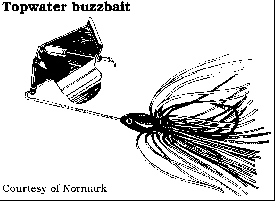
POINTERS FROM THE PROS
|
|
White
and Striped Bass Fishing

Watch the action of gulls or
other fish-eating birds at a reservoir. Check out where they're
surface feeding on small fish. Where gulls are feeding, there
will be schools of white bass as well. Try 'jump
fishing': get to the action area quickly, throttle back
upwind, shut off the motor, and drift down through surfacing
fish.
|
|
|
SPAWNING White Bass: Although white bass spawn very successfully in New Mexico waters (particularly Elephant Butte Lake), 70 of every 100 white bass spawned each year are caught by fishermen or die of natural causes. The low egg hatching success and high mortality of adults means a great number of eggs must be spawned to ensure good fishing. During mid-April to mid-May, when water temperatures reach 54 to 73 degrees, white bass begin spawning in large reservoirs, where they seek out gravel or rocky bottoms in shallow water upon which to deposit eggs. Striped Bass:It is doubtful that striped bass successfully reproduce on their own in New Mexico waters. Because of this, young striped bass are frequently stocked by the Department of Game and Fish at Elephant Butte Lake and Caballo Lake to maintain a population of trophy-sized stripers for anglers. |
|
|
Learn Fishing Part I Fishing for White and Striped Bass |
Learn Fishing Part III More White and Striped Bass |
|
Land of Enchantment Fishing & Hunting Adventures P.O. Box 1336 Elephant Butte Lake, New Mexico 87935 Local: (575) 740-4710 |
Learn Fishing I | Learn Fishing II | Learn Fishing III | Fishing Rates | Gift Certificates | Map | Hotels | RV Parks | Site Map | Other Links
© Copyright Land of Enchantment Fishing & Hunting Adventures
www.stripersnewmexico.com